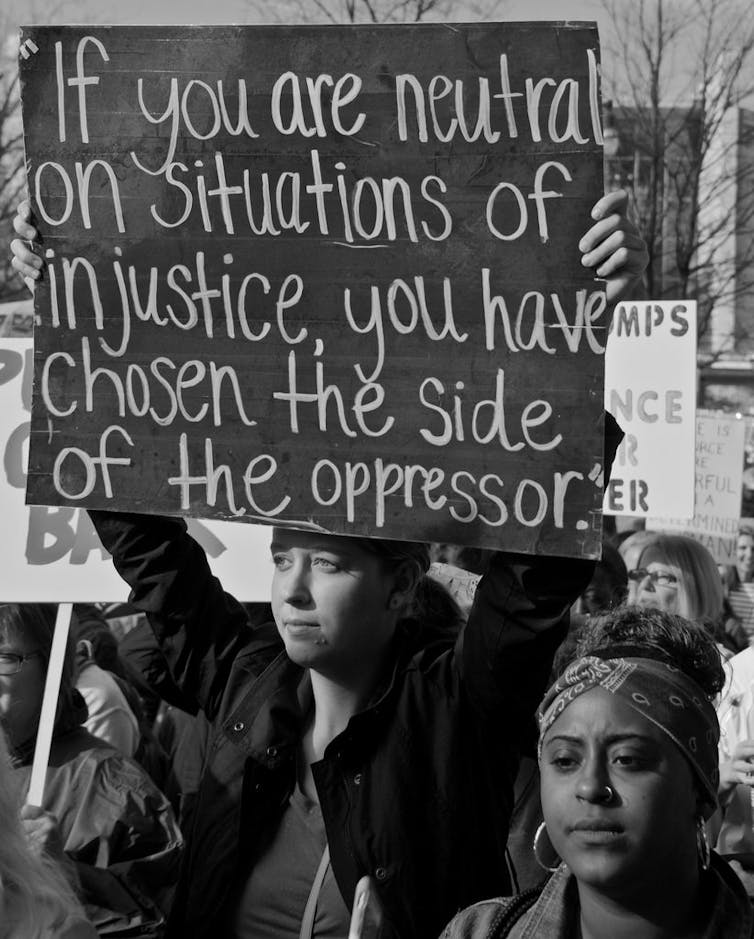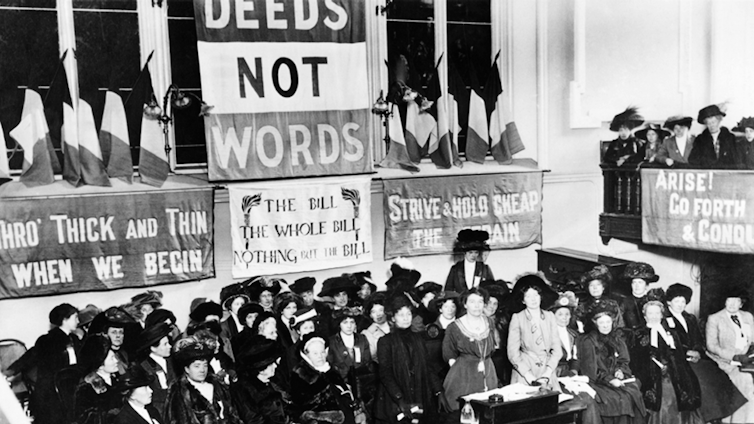International Women’s Day: Women have been written out of power – time is ripe for a new language of equality

2018 #HearOurVote women’s March in San Francisco. Gregory Varnum via Wikimedia Commons, CC BY-NC-SA
Ella Tennant, Keele University
As we mark International Women’s Day after a year of renewed media attention to issues of gender inequality, it could be that there are more important threats facing women and the survival of our planet, than mere words. But after the #MeToo campaigns, exposure of the gender pay gap, and recent publication of yet more research that challenges the idea of a gendered brain, it is mindboggling to see how “gendered blindness” – described as “the one-size-fits-men approach” in design and tech culture – lives on.
Meanwhile women’s equal contribution to society and culture is ignored. Visible women – those in the public eye or who call out unfair treatment – are subject to scrutiny and treated suspiciously in a way that men are not.
Gender scholars have argued that English is a language made by men for men with the sole purpose of representing and perpetuating their point of view. The way we see the world is therefore shaped by patriarchal traditions and this is evident in most areas of arts, culture and society. It is no surprise then, to see that women are marked as deviant and deficient, or worse, made invisible. In Women and Power, Mary Beard discusses “countless examples of attempts to write women entirely out of public discourse”.
The words we use play a role in this because language has the power to perpetuate gender determinism and, in doing so, to marginalise women. But our words can also be used in inclusive ways to promote equality and social justice. So it can’t be fair that there are more derogatory terms for girls and women than for boys and men (whore, hussy, spinster, hag, are some examples) and that the continued use of generic words or forms – man, mankind – are supposed to be all-inclusive and designate human beings in general. Meanwhile when “woman” is used as a label, it is a category with limiting criteria.
Nevertheless, any discussion about the link between language and gender discrimination often results in predictable comments about the trivial nature of the issue. It is this attitude that contributes to perpetuating male power and authority at the expense of women.
Defining status
Language defines women’s position as inferior in relation to men. Unlike some other languages, English is not a gendered language – but gender is still often arbitrarily used for some things. Cognitive research suggests that language and the way people use it has a profound influence on the way we see the world.

The way we communicate with others can be influenced by a number of things, including the relationship of the speakers, their age, social status and gender. If we view language as a form of social practice, then the way in which words – whether spoken or written – are received and interpreted by the listener reveal a great deal about how power relations are established and reinforced.
Even the allocation of names and titles can be seen as an act of power. A name or a label denotes a person’s social place and women are still often singled out by marital status, or “nubility titles” – Mrs or Miss – despite the fact that other options exist.
Although Ms, the preferred form of address for many women, is provided as a choice on a number of forms and drop-down menus, it is not used as a default. Another alternative, Mx, is gaining in popularity among transgender and non-binary communities and can be used by everyone as a way to go beyond gender labelling. An interviewee on a radio podcast explained:
What’s nice about Mx as a title is that it tells you nothing about a person. It doesn’t tell you their gender; it doesn’t tell you their marital status; it doesn’t tell you their qualifications or not. In the widest possible sense, it is for everyone.
Nevertheless, this does not yet appear to have yet caught on in mainstream communication, and women tend to be addressed based on their apparent gender and the speaker’s own assumptions and cultural conditioning. These assumptions can also be challenged by the use of gender-neutral or preferred pronouns. The most popular alternatives – along with “they” – are “ze”, or “hir”, from Marge Piercy’s 1976 feminist sci-fi utopia Woman on the Edge of Time.

Hundreds of other possibilities are available and some institutions allow people to self-identify with whatever pronoun they feel comfortable. However, adoption of the gender-neutral pronoun, such as “ze” has been described by linguists as an “epic fail”. It is hard to pronounce naturally and there are few signs of it becoming widely used.
Women are also more likely to be addressed by their first names than men, which is an indicator of perhaps unconscious, but no less patronising, gender politics. It could be argued that this might be a way of avoiding offence, for those who might not know the person’s marital status, but this just supports the point that men are not subject to the same categorisation.
For hundreds of years only women suffered discrimination on the grounds of their sex (as opposed to sexual orientation). This is emphasised in early feminist writing, such as that of Germaine Greer and Florynce Kennedy to illustrate this, and that it happens in situations that demand the sharing of power – when a more powerful group is asked to make concessions to a less powerful group, resistance is the likely outcome.
It is not easy to change culturally conditioned ways of behaving and thinking, but the continued perpetuation and reinforcement of cultural and social stereotypes through language cannot be dismissed as something trivial. The need for a conscious change or awareness of how words are used has become ever more urgent – for inclusivity in communication and to support gender equality.![]()
Ella Tennant, English Language Teaching Fellow, Keele University
This article is republished from The Conversation under a Creative Commons license. Read the original article.
Most read
- Astronomer from Keele helps take the first close-up picture of a dying star outside our galaxy
- Keele University signs official partnership with Cheshire College South & West
- Keele partners with regional universities to tackle maternity inequalities across the West Midlands
- Keele Business School MBA ranks in Top 40 for sustainability in prestigious global ranking
- Keele trains next generation of radiographers using virtual reality in regional first
Contact us
Andy Cain,
Media Relations Manager
+44 1782 733857
Abby Swift,
Senior Communications Officer
+44 1782 734925
Adam Blakeman,
Press Officer
+44 7775 033274
Ashleigh Williams,
Senior Internal Communications Officer
Strategic Communications and Brand news@keele.ac.uk.

